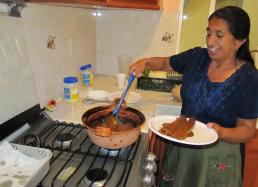5: Mitla, Town of Souls
From 1929 to 1933, the anthropologist Elsie Clews Parsons spent time in Mitla. Her visits were timed not only with the area’s destructive earthquake of 1931, but also with an era of relatively rapid change as new railroad and road connections between Mexico City and the Valley of Oaxaca introduced new technologies and products to the village dwellers of the region. Parsons published her studies of local life ways and folklore, Mitla: Town of Souls, in 1936, although the book and its numerous photographs were never translated into Spanish.
Today, we all went to the opening of a new temporary exhibition at the Mitla site museum that featured enlargements of the photographs in Parsons’ book. In finally bringing these historical images to Mitla, Mexico’s Institute of Anthropology and History has done a marvelous thing, since most people from Mitla have never seen these photos, nor are they aware of Parsons’ tome. In some cases, the images provide a chance for Mitleños to see a picture of a forebear for the first time!
Parsons entitled her book from an indigenous name of Mitla (Mitlan, “place of the dead” in the Nahuatl language of the Aztec). The name is derived from prehispanic accounts relating that late prehispanic rulers from other towns in the Valley of Oaxaca were buried in Mitla.
Although Mitla has at least 10,000 years of history, its most famous palatial ruins have long been recognized to date to the Postclassic period (ca. AD 900-1520). But, based on our recent work at the Mitla Fortress and studies led by Dr. Nelly Roblés García (INAH) in Mitla itself, we're starting to see that the Mitla palaces and the greatest importance of the site likely pertain to the first half of the Postclassic period (ca. AD 900-1250).
By the time the Spanish arrived, Mitla’s regional importance had waned a bit as other valley towns expanded their power. Mitla’s former grandeur may help account for the desire of later Postclassic leaders to be interred there, just as late prehispanic elites were added to an earlier tomb at Monte Albán, and just as the Aztecs conducted rituals at a former Basin of Mexico metropolis, Teotihuacan.
Last week, our attention at the Fortress was largely centered on the tomb as discussed in my last dispatch. Although we had hoped to turn our energies back to uncovering the architectural plan of the house on Terrace 276 that we're excavating, we were only half successful. Mitla: ciudad de los muertos (Mitla: city of the dead), as the local radio station intones, required us to refocus our efforts from defining rooms to studying the dead again.
Early in the week, we recovered two extended burials amidst the domestic architecture. And then on Friday, just when we thought we could marshal our attentions toward the deciphering of intricate changes made to the plan of the residence from one construction episode to the next (remodelings), we unexpectedly found three more burial contexts!
Of course, we learn a great deal from studying burials and their accompanying artifacts, nevertheless for proper study, significant time investments are needed in the field to expose and record them. So once more during the week ahead, as our excavation efforts by necessity will continue to be diffused, we'll be reminded of the prescience of Parsons’ title and its basis in Mitla’s history.
More soon,
Gary








